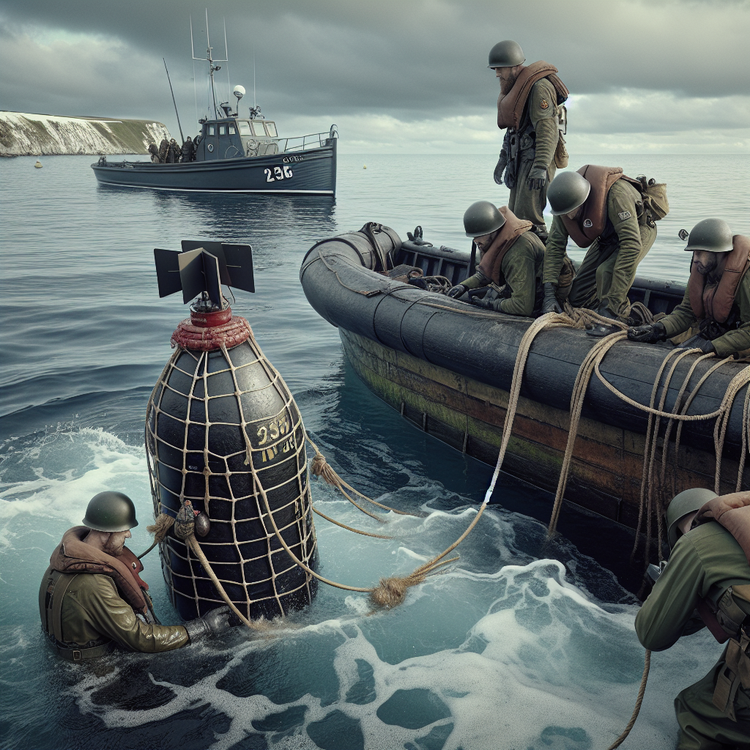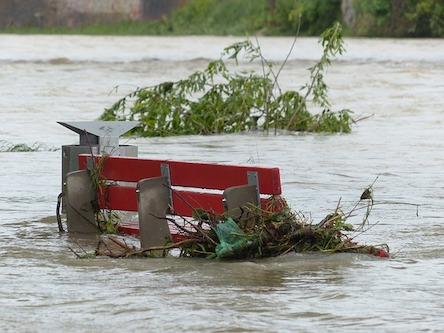A bomb from World War Two was found in the ocean near Denmark. It weighed 130kg and was discovered by a fisherman who told the authorities right away. To safely get rid of the bomb, experts from the Danish navy put it back in the water and attached a smaller bomb to it. They exploded it 15 meters below the surface.
The bomb was found near Langeland, a Danish island in the south of the country. It got stuck in the fisherman’s net, so he asked for help. The Danish navy acted quickly and did what they needed to do to make sure the bomb was exploded safely.
They exploded the bomb in a controlled way to make sure no one got hurt and nothing got damaged. By putting the bomb back in the water and attaching a smaller bomb to it, they were able to control the explosion and make sure it happened at a safe depth. This way, they got rid of the bomb without causing any harm to people or things.
This shows that World War Two still has an impact today and there are still bombs that haven’t exploded. It also shows how important it is for people to report things like this right away and for everyone to work together to deal with them. The Danish navy responded quickly and knew what to do, so everything turned out okay.
Original news source: World War Two bomb detonated off coast of Denmark (BBC)
Listen:
Slow
Normal
Fast
Vocabulary:
| 1 | bomb | A dangerous object that can explode and cause damage |
| 2 | World War Two | A war that happened a long time ago, involving many countries |
| 3 | ocean | A large body of saltwater |
| 4 | Denmark | A country in Northern Europe |
| 5 | fisherman | A person who catches fish for a living |
| 6 | authorities | People in charge who make decisions and enforce rules |
| 7 | safely | Without any danger or harm |
| 8 | rid | To remove or eliminate something |
| 9 | experts | People who have a lot of knowledge and skill in a particular area |
| 10 | navy | The part of a military force that operates at sea |
| 11 | exploded | To burst or break apart with a loud noise |
| 12 | surface | The outermost layer or top part of something |
| 13 | island | A piece of land surrounded by water |
| 14 | stuck | Unable to move or become unstuck |
| 15 | harm | Damage or injury caused by someone or something |
Group or Classroom Activities
Warm-up Activities:
– News Summary
Instructions: Divide the class into pairs. Each pair will have two minutes to read the article together. After the two minutes, one student will summarize the article to their partner in their own words. Then, the roles will switch and the other student will summarize the article. After both students have summarized, they can compare their summaries and discuss any differences.
– Opinion Poll
Instructions: Divide the class into small groups. Give each group a list of questions related to the article, such as “Do you think it is important for people to report dangerous items they find?” or “How do you think the Danish navy handled the situation?” Each group will discuss the questions and record their group’s opinions. After a designated time, each group will share their opinions with the class and facilitate a class discussion.
– Keyword Taboo
Instructions: Write a list of key vocabulary words from the article on the board. Divide the class into two teams. One student from each team will come to the front of the class. The teacher will choose a word from the list and show it to the two students. The students must describe the word to their team without using the actual word or any derivatives of it. The first team to guess the word correctly gets a point. Continue with different words and rotate the students at the front.
– Vocabulary Pictionary
Instructions: Divide the class into small groups. Give each group a set of vocabulary words from the article. One student from each group will choose a word and draw a picture to represent it, without using any letters or numbers. The other students in the group must guess the word based on the drawing. The student who drew the picture can give hints or gestures, but cannot speak. The group that guesses the most words correctly wins.
– Future Predictions
Instructions: In pairs, have the students discuss and make predictions about the future impact of World War Two bombs. They should consider questions like “Will more bombs be found in the future?” or “How will countries continue to deal with unexploded bombs?” After the discussion, pairs can share their predictions with the class and engage in a class discussion about the topic.
Comprehension Questions:
1. Where was the bomb from World War Two found?
2. How much did the bomb weigh?
3. Who discovered the bomb and what did they do?
4. How did the Danish navy get rid of the bomb?
5. Why did they attach a smaller bomb to the original bomb?
6. Where was the bomb exploded?
7. Why did they explode the bomb in a controlled way?
8. What does this incident show about the impact of World War Two and the importance of reporting dangerous things?
Go to answers ⇩
Listen and Fill in the Gaps:
A bomb from World War Two was found in the ocean near (1)______. It weighed 130kg and was (2)______ by a fisherman who told the authorities right away. To safely get rid of the bomb, experts from the (3)______ navy put it back in the water and attached a smaller bomb to it. They exploded it 15 (4)______ below the surface.
The bomb was found near Langeland, a Danish island in the (5)______ of the country. It got stuck in the fisherman’s net, so he (6)______ for help. The Danish navy acted quickly and did what they needed to do to make sure the bomb was (7)______ safely.
They exploded the bomb in a (8)______ way to make sure no one got hurt and nothing got damaged. By (9)______ the bomb back in the (10)______ and attaching a smaller bomb to it, they were able to control the explosion and make sure it happened at a safe depth. This way, they got rid of the bomb without (11)______ any harm to (12)______ or things.
This shows that World War Two still has an impact today and there are still (13)______ that haven’t exploded. It also (14)______ how (15)______ it is for people to report things like this right away and for everyone to work together to deal with them. The Danish navy responded quickly and knew what to do, so everything (16)______ out okay.
Go to answers ⇩
Discussion Questions:
Students can ask a partner these questions, or discuss them as a group.
1. What is a bomb from World War Two?
2. How do you think the fisherman felt when he found the bomb in his net?
3. Have you ever found something unusual or dangerous? How did you react?
4. Do you think it was a good idea for the fisherman to ask for help? Why or why not?
5. How would you feel if you found a bomb in the ocean while fishing?
6. Do you think the Danish navy made the right decision by exploding the bomb underwater? Why or why not?
7. What do you think would have happened if the bomb hadn’t been discovered and exploded safely?
8. How important do you think it is for people to report dangerous things they find? Why or why not?
9. Have you ever had to work together with others to solve a problem? What was the problem and how did you solve it?
10. Do you think it’s surprising that there are still bombs from World War Two that haven’t exploded? Why or why not?
11. How do you think the Danish navy felt after successfully exploding the bomb without causing harm?
12. What do you think are some other ways that World War Two still has an impact today?
13. Do you think the fisherman should receive any recognition or reward for finding the bomb? Why or why not?
14. How do you think the fisherman’s life might have been different if he hadn’t found the bomb in his net?
15. What safety precautions do you think the Danish navy took to ensure the controlled explosion?
Individual Activities
Vocabulary Meanings:
Match each word to its meaning.
Words:
1. bomb
2. World War Two
3. ocean
4. Denmark
5. fisherman
6. authorities
7. safely
8. rid
9. experts
10. navy
11. exploded
12. surface
13. island
14. stuck
15. harm
Meanings:
(A) A dangerous object that can explode and cause damage
(B) Damage or injury caused by someone or something
(C) A country in Northern Europe
(D) The outermost layer or top part of something
(E) People who have a lot of knowledge and skill in a particular area
(F) The part of a military force that operates at sea
(G) Without any danger or harm
(H) Unable to move or become unstuck
(I) To burst or break apart with a loud noise
(J) A piece of land surrounded by water
(K) A war that happened a long time ago, involving many countries
(L) A person who catches fish for a living
(M) A large body of saltwater
(N) To remove or eliminate something
(O) People in charge who make decisions and enforce rules
Go to answers ⇩
Multiple Choice Questions:
1. How was the bomb discovered?
(a) A scuba diver found it near the shore
(b) A hiker found it on a Danish island
(c) A fisherman found it in the ocean
(d) A sailor found it in a shipwreck
2. What did the fisherman do when he found the bomb?
(a) He kept it as a souvenir
(b) He tried to dispose of it himself
(c) He ignored it and continued fishing
(d) He immediately informed the authorities
3. How did the Danish navy safely explode the bomb?
(a) They put it back in the water and attached a smaller bomb to it
(b) They transported it to a remote location and detonated it
(c) They dismantled it piece by piece
(d) They buried it deep underground
4. Where was the bomb found?
(a) Near Langeland, a Danish island in the south of the country
(b) Near Copenhagen, the capital city of Denmark
(c) Near Aarhus, the second-largest city in Denmark
(d) Near Odense, the birthplace of Hans Christian Andersen
5. Why did the fisherman ask for help?
(a) He wanted to sell the bomb for a profit
(b) The bomb got stuck in his net
(c) He was scared of the bomb and wanted someone else to deal with it
(d) He thought the bomb might be valuable and wanted an expert’s opinion
6. Why did the Danish navy explode the bomb in a controlled way?
(a) To study the effects of the explosion on marine life
(b) To test their bomb disposal skills
(c) To create a spectacle for the public
(d) To ensure the safety of people and prevent damage
7. What does this incident show about World War Two?
(a) It was a war fought primarily at sea
(b) It had no lasting effects on Denmark
(c) It still has an impact today, with unexploded bombs remaining
(d) It is a forgotten part of history
8. What is the main lesson to be learned from this incident?
(a) The need for better bomb disposal technology
(b) The importance of reporting dangerous discoveries promptly
(c) The dangers of fishing near Danish islands
(d) The insignificance of World War Two in modern times
Go to answers ⇩
True or False Questions:
1. The bomb was found far away from Langeland, a Danish island in the north of the country.
2. A bomb from World War Two was discovered in the ocean near Denmark.
3. To do this, they removed the bomb from the water and attached a smaller bomb to it.
4. This incident highlights the ongoing impact of World War Two and the importance of reporting such discoveries promptly.
5. Experts from the Danish navy safely disposed of the bomb.
6. The bomb was exploded 15 meters below the surface.
7. The bomb weighed 130g and was found by a fisherman.
8. The fisherman delayed informing the authorities about the bomb.
Go to answers ⇩
Write a Summary:
Write a summary of this news article in two sentences.
Check your writing now with the best free AI for English writing!
Writing Questions:
Answer the following questions. Write as much as you can for each answer.
Check your answers with our free English writing assistant!
1. What was found in the ocean near Denmark?
2. How much did the bomb weigh?
3. Who discovered the bomb and what did they do?
4. How did the Danish navy safely get rid of the bomb?
5. What does this incident show about the impact of World War Two and the importance of reporting such findings?
Answers
Comprehension Question Answers:
1. Where was the bomb from World War Two found?
The bomb was found in the ocean near Denmark.
2. How much did the bomb weigh?
The bomb weighed 130kg.
3. Who discovered the bomb and what did they do?
The bomb was discovered by a fisherman who told the authorities right away.
4. How did the Danish navy get rid of the bomb?
The Danish navy put the bomb back in the water and attached a smaller bomb to it, then exploded it.
5. Why did they attach a smaller bomb to the original bomb?
They attached a smaller bomb to the original bomb to control the explosion and ensure it happened at a safe depth.
6. Where was the bomb exploded?
The bomb was exploded 15 meters below the surface of the water.
7. Why did they explode the bomb in a controlled way?
They exploded the bomb in a controlled way to make sure no one got hurt and nothing got damaged.
8. What does this incident show about the impact of World War Two and the importance of reporting dangerous things?
This incident shows that World War Two still has an impact today and there are still bombs that haven’t exploded. It also highlights the importance of reporting dangerous things promptly and working together to deal with them.
Go back to questions ⇧
Listen and Fill in the Gaps Answers:
(1) Denmark
(2) discovered
(3) Danish
(4) meters
(5) south
(6) asked
(7) exploded
(8) controlled
(9) putting
(10) water
(11) causing
(12) people
(13) bombs
(14) shows
(15) important
(16) turned
Go back to questions ⇧
Vocabulary Meanings Answers:
1. bomb
Answer: (A) A dangerous object that can explode and cause damage
2. World War Two
Answer: (K) A war that happened a long time ago, involving many countries
3. ocean
Answer: (M) A large body of saltwater
4. Denmark
Answer: (C) A country in Northern Europe
5. fisherman
Answer: (L) A person who catches fish for a living
6. authorities
Answer: (O) People in charge who make decisions and enforce rules
7. safely
Answer: (G) Without any danger or harm
8. rid
Answer: (N) To remove or eliminate something
9. experts
Answer: (E) People who have a lot of knowledge and skill in a particular area
10. navy
Answer: (F) The part of a military force that operates at sea
11. exploded
Answer: (I) To burst or break apart with a loud noise
12. surface
Answer: (D) The outermost layer or top part of something
13. island
Answer: (J) A piece of land surrounded by water
14. stuck
Answer: (H) Unable to move or become unstuck
15. harm
Answer: (B) Damage or injury caused by someone or something
Go back to questions ⇧
Multiple Choice Answers:
1. How was the bomb discovered?
Answer: (c) A fisherman found it in the ocean
2. What did the fisherman do when he found the bomb?
Answer: (d) He immediately informed the authorities
3. How did the Danish navy safely explode the bomb?
Answer: (a) They put it back in the water and attached a smaller bomb to it
4. Where was the bomb found?
Answer: (a) Near Langeland, a Danish island in the south of the country
5. Why did the fisherman ask for help?
Answer: (b) The bomb got stuck in his net
6. Why did the Danish navy explode the bomb in a controlled way?
Answer: (d) To ensure the safety of people and prevent damage
7. What does this incident show about World War Two?
Answer: (c) It still has an impact today, with unexploded bombs remaining
8. What is the main lesson to be learned from this incident?
Answer: (b) The importance of reporting dangerous discoveries promptly
Go back to questions ⇧
True or False Answers:
1. The bomb was found far away from Langeland, a Danish island in the north of the country. (Answer: False)
2. A bomb from World War Two was discovered in the ocean near Denmark. (Answer: True)
3. To do this, they removed the bomb from the water and attached a smaller bomb to it. (Answer: False)
4. This incident highlights the ongoing impact of World War Two and the importance of reporting such discoveries promptly. (Answer: True)
5. Experts from the Danish navy safely disposed of the bomb. (Answer: True)
6. The bomb was exploded 15 meters below the surface. (Answer: True)
7. The bomb weighed 130g and was found by a fisherman. (Answer: False)
8. The fisherman delayed informing the authorities about the bomb. (Answer: False)
Go back to questions ⇧













